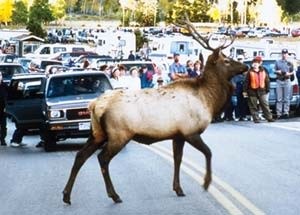Last updated: September 20, 2017
Article
Elk Body Condition

The Question: Have elk reached ecological carrying capacity in Rocky? Is population growth limited by food availability?
While large herds of elk are a popular attraction in Rocky Mountain National Park, the management of elk has been a controversial topic since park managers adopted a natural regulation management policy in 1968. Biologists have recently debated whether the elk population within the park has reached an ecological carrying capacity wherein elk numbers are limited by the availability of food.The Project: Administer several health tests to 79 adult elk cows between 2001-2002.
In November 2001 and April 2002 Dr. Louis Bender and assistants from the New Mexico Cooperative Fish and Wildlife Research Unit captured a total of 79 adult elk cows in Moraine Park and Horseshoe Park (locations within Rocky Mountain National Park). These two locations have the highest density of elk on winter range in the park, densities that are among the highest ever observed for elk in natural environments. They captured each animal using ground-darting techniques and injected each with antibiotics and vitamins to mitigate ill effects from handling. They measured body fat percentage, fall and spring, using ultrasound. They determined pregnancy using ultrasound in November and internal palpation in April. Finally the scientists drew blood to test for disease before the animal was revived and released. They then compared data collected to similar data taken from elk herds across the west.The Results: Elk body condition assessments suggest that park elk are not yet at ecological carrying capacity based on food availability.
The body conditions of adult elk cows from Horseshoe Park and Moraine Park were below that which could be achieved with good nutrition but not as low as would be expected if the herds were at carrying capacity. Pregnancy rates were 86 percent in Horseshoe Park and 60 percent in Moraine Park, effects higher percentages than anticipated. The survival rate of cow elk is a whopping 93 percent, the second highest documented rate in an significantly elk population. The primary cause of death of cow elk in Rocky Mountain National Park is old age. A few of the elk tested proved to be in excellent condition, indicating that there is still some high quality food available to them.
As typical in nature a number of diseases are present in the elk population. Elk may serve as a pasteurellosis, a type of pneumonia.
Overall body condition for the herds in Horseshoe Park and Moraine Park was better than expected for such a dense winter range population. Even though the Moraine Park herd is in worse condition than the Horseshoe Park herd, without control measures both populations can be expected to increase in number.
Both body condition test results and cow elk survival rates indicate that the elk population is still below ecological carrying capacity. Based on this study the elk population in Rocky Mountain National Park may be overabundant with respect to desired vegetation conditions but not with respect to the ability of plant communities to support elk.
This summary is based on published, peer-reviewed and/or unpublished reports available at the time of writing. It is not intended as a statement of park policy or as a definitive account of research results. For more information on the park’s research program, see www.nps.gov/romo.
Written by: Judy Visty Date: November 2004 Updated: January 2008
